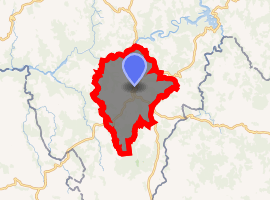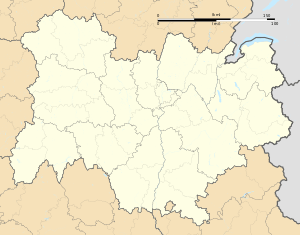Chaudes-Aigues
Chaudes-Aigues (French: [ʃodz‿ɛɡ]; Occitan: Chaudas Aigas, lit. '"Hot Waters"') is a commune in the Cantal department in south-central France. It is a spa town, famous for its hot spring waters.
Chaudes-Aigues | |
|---|---|
Source of the Par and museum | |
.svg.png) Coat of arms | |
Location of Chaudes-Aigues 
| |
 Chaudes-Aigues  Chaudes-Aigues | |
| Coordinates: 44°51′19″N 3°00′17″E | |
| Country | France |
| Region | Auvergne-Rhône-Alpes |
| Department | Cantal |
| Arrondissement | Saint-Flour |
| Canton | Neuvéglise |
| Intercommunality | Caldaguès-Aubrac |
| Government | |
| • Mayor (2008–2014) | Madeleine Baumgartner |
| Area 1 | 53.16 km2 (20.53 sq mi) |
| Population (2017-01-01)[1] | 886 |
| • Density | 17/km2 (43/sq mi) |
| Time zone | UTC+01:00 (CET) |
| • Summer (DST) | UTC+02:00 (CEST) |
| INSEE/Postal code | 15045 /15110 |
| Elevation | 637–1,280 m (2,090–4,199 ft) (avg. 750 m or 2,460 ft) |
| 1 French Land Register data, which excludes lakes, ponds, glaciers > 1 km2 (0.386 sq mi or 247 acres) and river estuaries. | |
Geography
The commune is situated in the Massif Central in Aubrac. Its inhabitants are called the Caldaguès, from the Latin meaning 'hot waters', or in French, eaux chaudes; hence the name of the commune, Chaudes-Aigues
As its name suggests, there are thirty natural hot water sources with temperatures ranging from 45° to more than 80°. The most famous is the source of the Par river with a water temperature of 82° - the hottest in Europe - with a flow in the region of 450,000 litres a day. One local story suggests that the source is so-named because a pig was dressed (paré) or jointed thanks to the hot water. The waters are used all year round. In winter, they have provided heat for houses and the church as district heating since the 14th Century;[2][3] from spring the waters are channeled to the spa for the treatment of rheumatics.
The Remontalou crosses the commune.
Population
| Year | Pop. | ±% |
|---|---|---|
| 1962 | 1,218 | — |
| 1968 | 1,114 | −8.5% |
| 1975 | 1,187 | +6.6% |
| 1982 | 1,186 | −0.1% |
| 1990 | 1,110 | −6.4% |
| 1999 | 986 | −11.2% |
| 2008 | 954 | −3.2% |
Sights
The Château de Couffour is a ruined castle, dating back to the 15th century, situated in the commune.
See also
References
- "Populations légales 2017". INSEE. Retrieved 6 January 2020.
- Bloomquist, R. Gordon (2001). Geothermal District Energy System Analysis, Design, and Development (PDF). International Summer School. International Geothermal Association. p. 213(1). Retrieved November 28, 2015. Lay summary – Stanford University.
During Roman times, warm water was circulated through open trenches to provide heating for buildings and baths in Pompeii.
- Lund, John W. (June 2007), "Characteristics, Development and utilization of geothermal resources" (PDF), Geo-Heat Centre Quarterly Bulletin, Klamath Falls, Oregon: Oregon Institute of Technology, 28 (2), pp. 1–9, ISSN 0276-1084, retrieved 2009-04-16